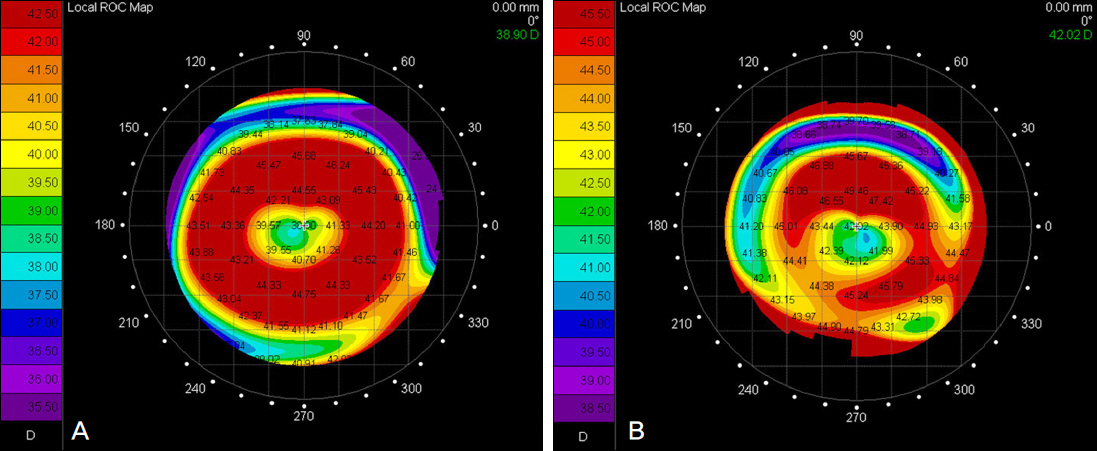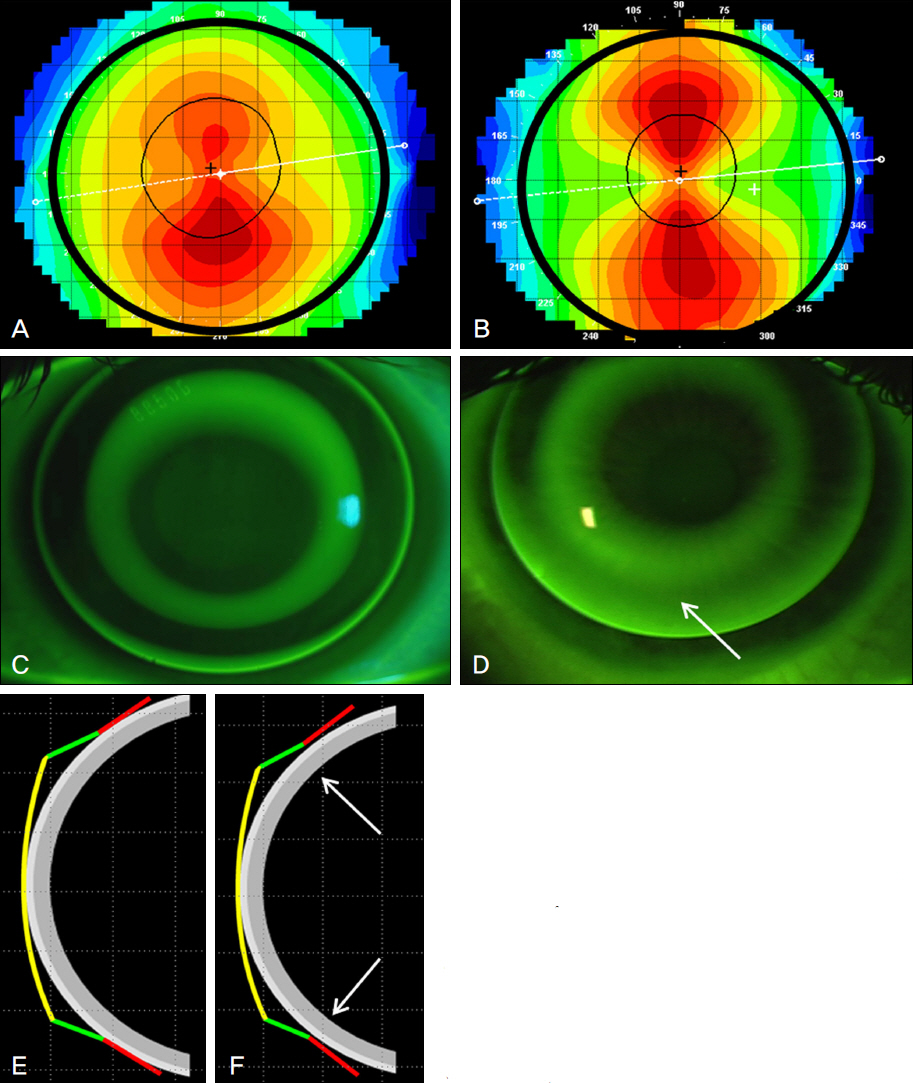J Korean Ophthalmol Soc.
2013 Mar;54(3):502-507. 10.3341/jkos.2013.54.3.502.
Correction of Limbus-to-Limbus Corneal Astigmatism with Toric Orthokeratology Lenses
- Affiliations
-
- 1Park Young Kee Eye Clinic, Seoul, Korea.
- 2Department of Ophthalmology, Pusan National University School of Medicine, Busan, Korea. jiel75@hanmail.net
- KMID: 2216773
- DOI: http://doi.org/10.3341/jkos.2013.54.3.502
Abstract
- PURPOSE
To report the efficacy of toric orthokeratology lenses in a patient with corneal astigmatism within 1.5 D having difficulty wearing spherical orthokeratology lenses because of limbus-to-limbus corneal astigmatism.
CASE SUMMARY
An 11-year-old boy who wanted to wear orthokeratology lenses had a refractive error of -4.75 D sph = -1.00 D cyl 180 in the right eye and -4.50 D sph = -1.25 D cyl 180 in the left eye. The corneal astigmatism was 1.19 D and 1.19 D, respectively, and limbus-to-limbus corneal astigmatism was observed in topography. After wearing spherical orthokeratology lenses, the patient complained of monocular diplopia and both lenses were found to be displaced nasally. Toric orthokeratology lenses were prescribed for centration of lenses and resulted in significant improvement of uncorrected visual acuity of 20/20, refractive error of +0.75 D sph = -0.50 D cyl 170 in the right eye and +0.50 D sph = -0.50 D cyl 160 in the left eye, and centration of lenses for the 12-month follow-up period.
CONCLUSIONS
Toric orthokeratology lenses should be considered if spherical orthokeratology lenses are not effective even in patients having less than 1.5 D of corneal astigmatism because of limbus-to-limbus corneal astigmatism.
Keyword
Figure
Cited by 2 articles
-
Effect of Toric Orthokeratology Lenses on Patients with More Than 1.5 Diopter of Corneal Astigmatism
Jong Heon Lee, Young Min Park, Young Kee Park, Jong Su Lee, Hee Young Choi, Jae Ho Jung, Ji Eun Lee
J Korean Ophthalmol Soc. 2015;56(6):830-834. doi: 10.3341/jkos.2015.56.6.830.Effect of Toric Orthokeratology Lenses in Patients with Limbus to Limbus Corneal Astigmatism
Young Min Park, Jong Heon Lee, Young Kee Park, Jong Su Lee, Hee Young Choi, Jae Ho Jung, Ji Eun Lee
J Korean Ophthalmol Soc. 2015;56(7):980-984. doi: 10.3341/jkos.2015.56.7.980.
Reference
-
References
1. Cho P, Cheung SW, Edwards M. The longitudinal orthokeratology research in children (LORIC) in Hong Kong: a pilot study on refractive changes and myopic control. Curr Eye Res. 2005; 30:71–80.
Article2. Lee WH, Park YK, Seo JM, Shin JH. The inhibitory effect of myopic and astigmatic progression by orthokeratology lens. J Korean Ophthalmol Soc. 2011; 52:1269–74.
Article3. Chan B, Cho P, Cheung SW. Orthokeratology practice in children in a university clinic in Hong Kong. Clin Exp Optom. 2008; 91:453–60.
Article4. Mountford J, Pesudovs K. An analysis of the astigmatic changes induced by accelerated orthokeratology. Clin Exp Optom. 2002; 85:284–93.
Article5. Sanders DR, Koch DD. An atlas of corneal topography, 1st ed. New Jersey: Slack Incorporated;1993. p. 5563.6. Pauné J, Cardona G, Quevedo L. Toric double tear reservoir contact lens in orthokeratology for astigmatism. Eye Contact Lens. 2012; 38:245–51.
Article7. Chen CC, Cheung SW, Cho P. Toric orthokeratology for highly astigmatic children. Optom Vis Sci. 2012; 89:849–55.
Article8. Chen C, Cho P. Toric orthokeratology for high myopic and astigmatic subjects for myopic control. Clin Exp Optom. 2012; 95:103–8.
Article9. Chan B, Cho P, de Vecht A. Toric orthokeratology: a case report. Clin Exp Optom. 2009; 92:387–91.
Article
- Full Text Links
- Actions
-
Cited
- CITED
-
- Close
- Share
- Similar articles
-
- Effect of Toric Orthokeratology Lenses in Patients with Limbus to Limbus Corneal Astigmatism
- The Effect of Astigmatism Correction in Myopic Astigmatism by Toric Lenses: Comparison with Hard Contact Lenses
- Effect of Toric Orthokeratology Lenses on Patients with More Than 1.5 Diopter of Corneal Astigmatism
- Prescription and effect of orthokeratology lenses
- Astigmatic Changes after 6mm Scleral Tunnel Incisions at 1mm and 2.5mm from the Limbus in Sutureless Cataract Surgery





